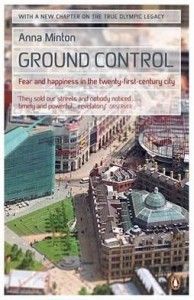Ground Control by Anna Minton
 Ground Control by Anna Minton
Ground Control by Anna Minton
Anna Minton has carefully researched and traced the outline of the policies in the UK behind not only the privatisation of public buildings and space, but have also shaped how we use and think about the city. Grand regeneration projects have turned public space with potential value to everyone into private, corporately managed and policed space, from which the original inhabitants have been all but excluded. Housing Projects have divided communities, created fear and loathing. CCTV and policing policy have exacerbated social divisions.
This thoroughly researched book takes us historically through the key projects and key policies that have brought us to this situation. From the Docklands in the late Eighties under Thaterism through to the present day taking in other major developments across the country. In Liverpool with Liverpool One and Manchester in Exchange Square to name a few of the other major developments that follow this model.
It’s a more encompassing book than just looking at the Urban developments though. It clearly links crime and fear of crime in the UK to the changes in the law and running of developments and housing in the UK. Government policies have reinforced or created these negative effects, the Pathfinder scheme, ASBO’s and Secured by Design. These policies along with the rise of gated communities all over the UK and of CCTV cameras (more in the UK that in the rest of Europe combined) which actually increases the fear and insecurity in society as well as social exclusion. As an example of good writing which clearly links social policy to concrete outcomes in the urban fabric of cities and with actual social outcomes this book sets the bar.
Published in 2009 around the last crash in 2012 an extra chapter was added to cover the Olympic Games of 2012 itself probably worthy of a book. In the conclusion Anna Minton tries to find some silver lining to the dark clouds. Urban Space Management stands out as the lone example she can muster, their Development in Trinity Buoy Wharf an example of how things could have been all over the country. It’s compelling but sobering stuff a must read for anyone in this field and hopefully it has helped to shine a light on an area of public policy which is so opaque but which we should be much more engaged with.
I can’t help but to link this book to The New Aesthetic, the blog by James Bridle that recognises the crossover of the net into the physical world. The use of drones and (mentioned in this book) the mosquito, CCTV and gated communities, all examples of places that exist because of new technology and the ability to produce action at a distance to monitor,control and segregate from anywhere anonymously. Is Britain becoming a visible artifact of the network of control and commerce which has grown up in the last twenty five years in the UK? I sure hope it’s not that bad.